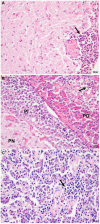Lymphocytic hypophysitis in dogs infected with Leishmania spp
- PMID: 37781278
- PMCID: PMC10537919
- DOI: 10.3389/fvets.2023.1208919
Lymphocytic hypophysitis in dogs infected with Leishmania spp
Abstract
Background: Morphological involvement of endocrine glands, such as the pituitary gland, remain uninvestigated in dogs with canine visceral leishmaniasis. Therefore, this study investigated the presence of amastigotes of Leishmania spp. and characterized inflammatory changes, highlighting the involvement of TCD3+ lymphocytes in different regions of the pituitary gland of dogs.
Methods: Samples were collected from 21 naturally infected dogs and 5 control, uninfected dogs. The different pituitary regions were analyzed in histological sections stained with hematoxylin and eosin (HE) under light microscopy. Inflammation was classified by intensity in a score from 0 to 3, absent (0), mild (1), moderate (2), and marked (3). The immunohistochemical (IHC) evaluation was performed in five high-power fields (hot spot) in a 40x objective of each region with manual counting (Image J1.52ª) of the TCD3+ lymphocytes and for amastigotes analyzed in 40x and 100x objectives. The Shapiro-Wilk test was used to assess the normality of the data. Differences between groups were determined by the Mann Whitney test. The correlation between variables was assessed by Sperman's correlation test. p < 0.05 were considered statistically significant.
Results: Amastigotes from the pituitary glands of two infected dogs were identified using IHC. The histopathological evaluation stained with hematoxylin and eosin showed greater intensity of inflammation in the pars distalis and pars intermedia regions of infected dogs. IHC for TCD3+ lymphocytes showed a higher median number of immunolabeled cells in pars nervosa in the infected group than in the control group (p < 0.05); and expecting a variation in the distribution and number of these cells in naturally infected dogs, the median of the control group was considered a cut-off point, an increase in T lymphocytes (p < 0.05) was also observed in the pars intermedia and pars distalis of an infected subgroup (n = 10). A moderate significant correlation between the intensity of inflammation and the number of immunolabeled TCD3+ lymphocytes was established in the analyzed pituitary regions, characterizing the occurrence of hypophysitis.
Conclusion: These findings presuppose that inflammation and/or the parasite in the pituitary region can result in gland dysfunction, worsening the clinical condition of the patient and compromising the efficiency of treatment and prognosis.
Keywords: Leishmania infantum; T lymphocyte; immunohistochemical; inflammation; pituitary gland.
Copyright © 2023 Frigerio, Guizelini, Jussiani, Março, de Melo, Watanabe and Machado.
Conflict of interest statement
The authors declare that the research was conducted in the absence of any commercial or financial relationships that could be construed as a potential conflict of interest.
Figures






References
LinkOut - more resources
Full Text Sources
Miscellaneous

